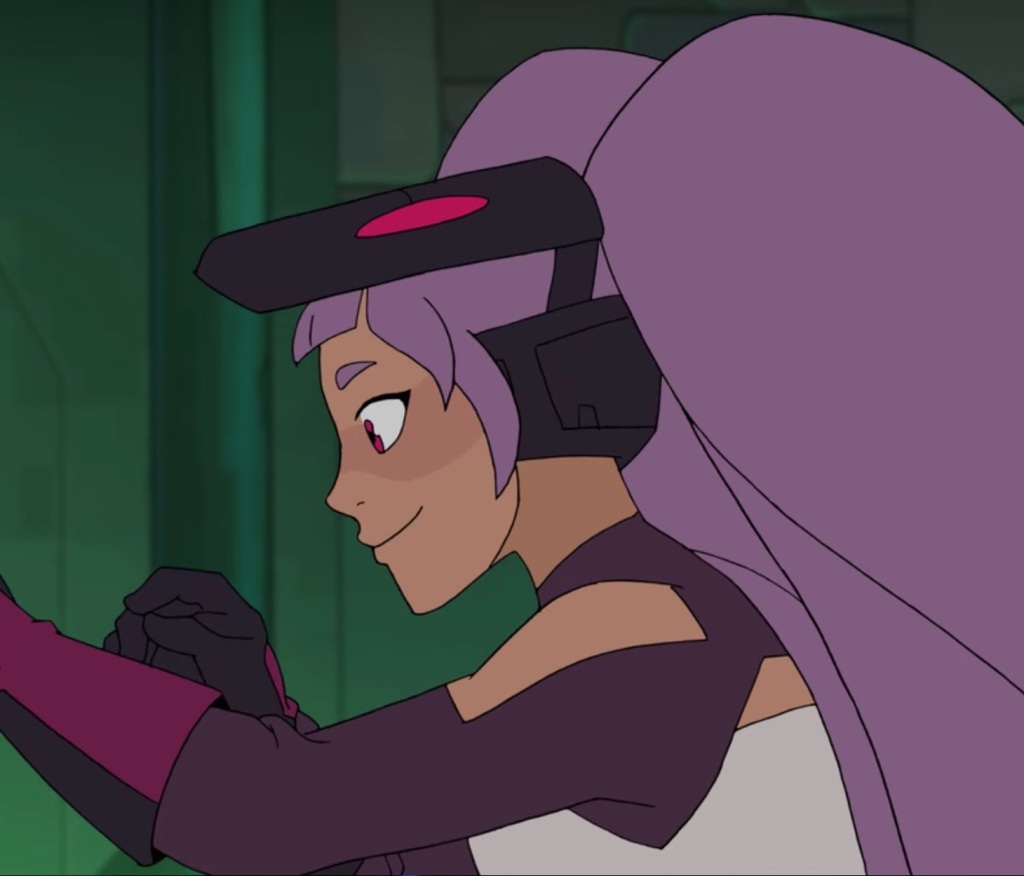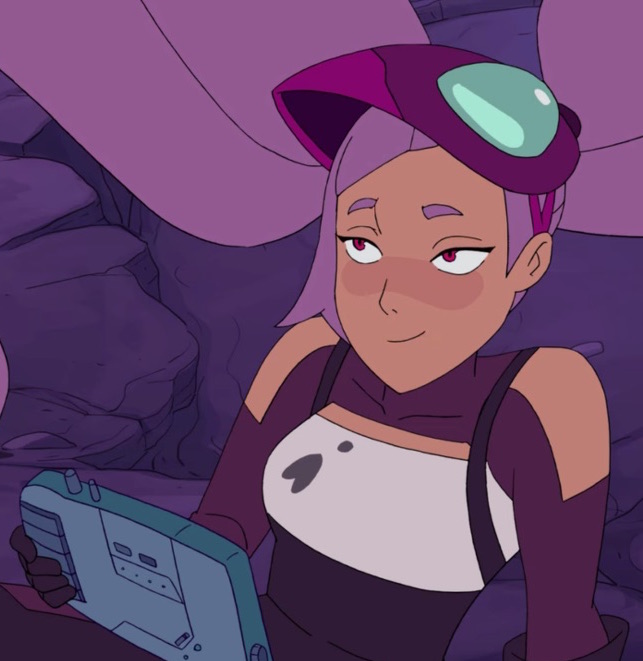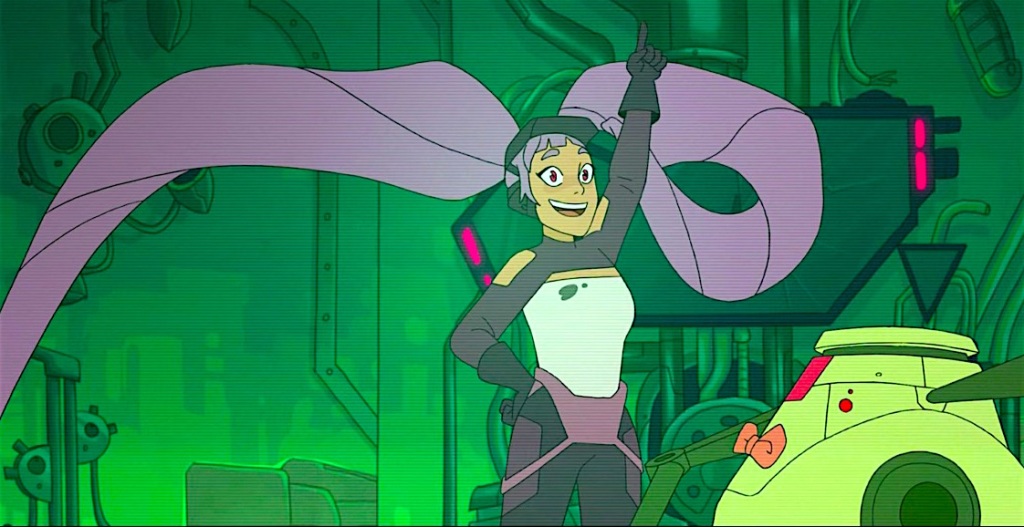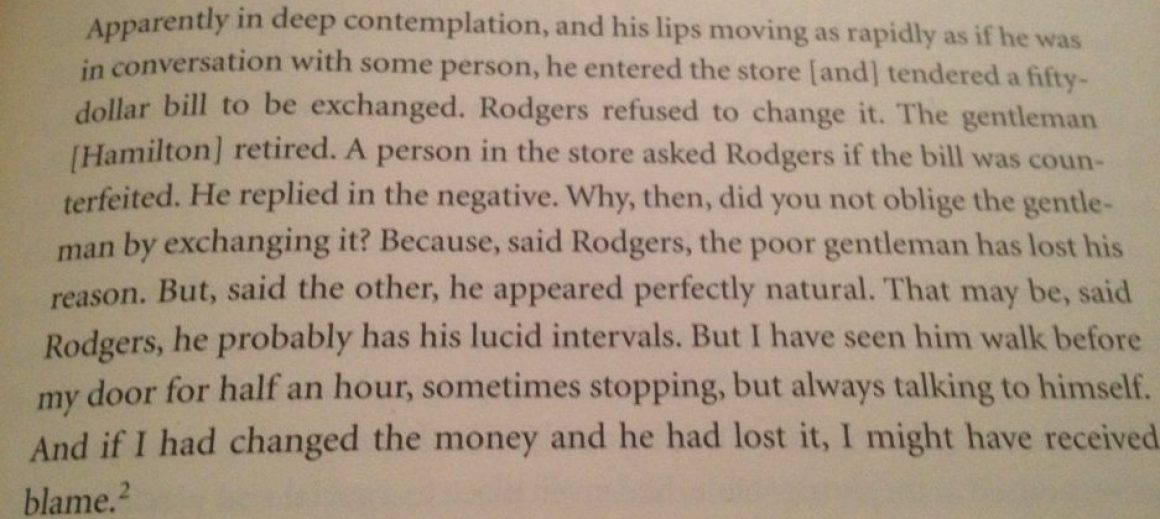
(Warning for spoilers for Seasons One and Two, with vague discussion of events in later seasons.)
Toward the end of the first season of She-Ra and the Princesses of Power, Princess Entrapta is told, possibly for the first time in her life, “You definitely belong here with us.” She reacts with genuine surprise. Then, in a blink-and-you-miss-it moment before she starts monologuing about plot-related science, she smiles. For me, this scene epitomizes why Entrapta is one of the most nuanced, respectfully-written autistic characters I have ever seen on TV.
Entrapta’s autism is clear from her introduction, even though showrunner Noelle Stevenson only confirmed it after the series finished in May 2020. She stims, infodumps, hyperfocuses, and struggles to stay in tune with the people around her. She has unbelievably strong splinter skills in engineering, as well as specific and idiosyncratic needs around food. She is earnest and literal, often missing the complexities of social situations. In a later season, we learn that Entrapta interprets interactions and relationships the same way that she processes everything else: through recorded observations and data analysis.
What makes Entrapta such a great example of autistic representation? There are a number of things. Let’s start with the most important one:
1. Entrapta’s creation was heavily influenced by an autistic member of the creative team.
Noelle Stevenson also confirmed in May 2020 that board artist Sam Szymanski, who is autistic, played a major role in creating Entrapta, including her physical actions and story arcs.
I am far from the first person to state the importance of allowing marginalized people to represent themselves in fiction. Check out the hashtag #OwnVoices for more information on that.
“Stories about autism” have been told by non-autistic people over and over and over again for decades, resulting in a whole spectrum (so to speak) of harmful tropes, from ableist jokes to inspiration porn to pity-parties for non-autistic family members.
If you want to tell a story about an autistic character in an authentic and inclusive way, you need to involve autistic people in its creation. We know what it’s like to live in a world that ostracizes us unless we camouflage ourselves, a world that makes unfair assumptions about what we can and cannot do, a world that sees our uniqueness as a fault and grieves for people forced to interact with us. We understand the experience of autism in a way that non-autistics don’t, and if you put our perspective into your story, you will speak to autistic people in a way that cannot be done without our input.
2. Entrapta lacks many of the stereotypes found in autistic characters.
Entrapta is not your typical autistic character. For starters, she is a woman, designed and often interpreted as a person of color. She shows a huge range of emotions and she genuinely cares about the people around her. She is nothing like the stoic, white, autistic boys that we are accustomed to seeing.



Entrapta displays a wide range of emotions throughout the series.
Entrapta shows an interest in romantic relationships. It is even implied, in a few humor-for-the-adults moments, that she is sexually active. The non-traditional nature of her interests aside (if you know who she’s looking at in that middle picture, you understand), it’s nice to see an autistic character – or a disabled character in general – who is not assumed to be aromantic and/or asexual by default. The real-life autistic and disabled communities contain a range of romantic and sexual orientations, so it’s refreshing to see something new represented.
Characters who get to know Entrapta discover that she is surprisingly self-aware. She wants to help people and she wants to be liked, but she knows that emotional connection is difficult for her in a way that it isn’t for other people. She also knows where her strengths lie and she tries to use them to make up for her interpersonal struggles.
In an interview just before the release of season five (warning for potential spoilers through season four), Noelle Stevenson talked about one of Entrapta’s most unique areas of strength:
(Entrapta) sees humanity in everything. Not just in humanoid or organic creatures, but she sees humanity in robots. She sees humanity in the AI that drives ships. She sees humanity in one clone in a million identical clones and knows their personality and knows who they are and knows how to connect with them… I think she does more than almost any other character in humanizing characters who have never been humanized before by anyone.
Entrapta sees humanity where no one else thinks to look. This strength flies in the face of the all-too-common stereotype that autistic people lack the ability to see humanity in ourselves, more or less in others. In this sense, Entrapta is more skilled at emotional connection than most of the non-autistic characters, which in media is a rare and exciting trait to see.
3. Entrapta’s autistic traits are often an asset.
Although it is not explicitly stated that Entrapta can see humanity in everything because of her autism, her ability to connect with non-humans can certainly be read that way. Entrapta knows what it’s like to have to learn the rules and complexities of interaction that come naturally to other people. As a result, she recognizes this struggle in other characters.
In Season Five, Entrapta teaches a non-human character about the subtle art of producing and interpreting facial expressions. It starts with a quick exchange:
[Name redacted]: You appear to have a facial tic. Is it cause for concern?
Entrapta: Oh, I’m winking. It signals unspoken intent behind my words. In this case, our mutual deception of [redacted]. Now you try.
This type of lesson comes naturally to Entrapta because, similar to the person she’s talking to, she interprets the world through concrete rules and definitions. She knows what works for her, and so she is uniquely qualified to impart these lessons to characters who struggle in the same way that she does.
Entrapta recognizes when characters use unorthodox ways to express appreciation, affection, or any kind of connection, because she does that too. She knows from experience what these characters need to hear: “I see you.” “I like you.” “I appreciate you.” “I want to be your friend.” And folks, this skill changes the direction of the series in a way I never would have predicted.

Obviously, there is also the matter of her cartoonishly strong talents in STEM and her interest in robotics, First Ones technology, and space travel. Savant-level genius in science and technology is not a unique feature of autistic characters in fiction. However, Entapta’s skills and passions are vitally important to many of the major plot points in the series. A number of events would have been impossible without her interest, focus, and talents. Although these traits are somewhat cliche for autistic characters, it is worth mentioning how much of the story would not have happened if Entrapta were neurotypical.
4. Interpersonal conflicts with Entrapta are multi-sided.
A few weeks ago I wrote a Twitter thread about a scene in Season Five (spoilers for Episodes One and Two in the thread), when a group of non-autistic characters drastically misinterpret Entrapta’s intentions. Entrapta seems so wrapped up in her interests that other characters assume she doesn’t care about people. This is definitively not the case, as she is in fact using her interests to try to help them, but Entrapta doesn’t realize anything is wrong until it’s almost too late.
Aspects of this scene ring painfully true to me as an autistic person. “Are you all…mad at me?” Entrapta asks, and my heart shatters. I have asked that exact question many times. I know very few autistic people who haven’t.
Entrapta is not completely at fault, which the show makes very clear. Non-autistic characters interpret her actions through a neurotypical perspective, which brings them to the wrong conclusions about her. Yes, previous events inform this particular conflict, but this pattern of communication breakdown appears as early as Season One.
Entrapta’s first episode introduces her as an eccentric and socially awkward genius. She doesn’t fit in with the Princesses, and to them it doesn’t seem like she’s trying. There are moments of escalating conflict culminating in the moment when the Rebellion abandons Entrapta in enemy territory.
In the Princesses’ defense: they have reason to believe she’s dead. In Entrapta’s defense: no one thinks to double-check.

If a different member of the Rebellion had been in Entrapta’s position, it’s likely that someone would have gone back for them, even with the evidence that they didn’t survive. But this is Entrapta. This is the Princess who doesn’t fit in. Without her, the Rebellion’s access to technology is limited, but their plans go the way they expect. The Princesses are more comfortable mourning Entrapta’s loss than interacting with her before her “death.”
However you interpret the situation, Entrapta’s perspective is clear. The Rebellion, whose motto until this point is “No Princess Left Behind,” leaves her behind enemy lines. She did not see it coming. She does not know why it happened. Her analysis of the available data indicates that the members of the Rebellion are not her friends. So it is understandable, if not justifiable, why she starts using her talents to support the Horde instead.
This is not to say that Entrapta is faultless (see #7), more that it is easy to understand why she makes the decisions that she does, given the circumstances.
Entrapta’s series-long arc is not about learning how to improve her social behavior and “fit in.” Yes, she makes an effort to express herself more clearly, but any character who wants to earn (or regain) her trust must first accept that her communication style is different from theirs, and sometimes that’s a good thing. Wrongs on both sides need to be addressed. Characters need to accept – even appreciate – Entrapta for who she is. The ones who do this become her closest and truest friends.
I cannot overstate how powerful it is to see an autistic person written with this perspective. Autistic characters, She-Ra tells us, are worth being seen. We are worth the effort. We are not at fault for every conflict, and other people deserve blame when they treat us unfairly. Not every breakdown is entirely ours to fix.
5. People falsely assume that Entrapta does not have empathy.
One of the biggest sources of conflict between Entrapta and other characters is the assumption that she lacks empathy. This misconception hits home with many members of the autistic community, who are often falsely accused of the same thing.
Because we don’t process or respond to emotions or situations in the same way that non-autistic people do, we are often assumed to not know – or worse, not care – how other people are feeling. Entrapta faces this problem from viewers as well as from characters.

After Season One aired, I read an otherwise fantastic article about Entrapta describing her as a “truly Chaotic Neutral” person. My only problem (and the reason I’m not linking to it here) is that the author assumed that Entrapta does not care how other people feel, how people view her, or about the harm her experiments cause.
Some of the otherwise sympathetic characters do the same thing, making claims such as, “You don’t care about [name redacted] or any of us. You only care about tech,” and “You don’t consider how your actions affect other people. People who are supposed to be your friends.” They are wrong on both counts. However, if you interpret Entrapta’s actions as if she were neurotypical, you might logically reach the same conclusion. These characters don’t understand that Entrapta doesn’t intuit emotions from indirect cues the way they can, or process or express information in the same way they do.
From the start, the show makes it clear that Entrapta does care about other people. She constantly uses her skills to try to help the people around her, and she genuinely enjoys making people happy. In a heartbreaking moment in Season One, her eyes fill with tears when she realizes the Rebellion has left her behind. Like many autistic people, Entrapta expresses her regard for others in ways that are unexpected, understated, or unusual, which causes non-autistic people – both fictional and non-fictional – to misinterpret her.
There’s a satisfying irony in this, as an autistic viewer who knows the “autistic-people-don’t-have-empathy” stereotype far too well. Entrapta is such an accurately-written autistic character that even non-autistic viewers think she doesn’t have empathy! Entrapta’s story isn’t just about us, it’s also for us.
6. Entrapta’s desire for friendship makes her a target for manipulation.
When discussing Entrapta’s allegiance with the Horde, there are two important considerations to make. First: in the Horde, Entrapta makes genuinely positive connections with people who accept and appreciate her for who she is, something that she did not have in the Rebellion. Second: her eagerness for companionship is taken advantage of, and she is deliberately manipulated into doing harmful things.
Again, none of this is intended to justify or minimize what Entrapta did when she was with the Horde. See #7.
The Horde is the first place where Entrapta interacts with people who like her for her uniqueness, not in spite of it. She forms real, lasting friendships and feels more comfortable with the Horde than she ever did with the Rebellion.

For the first time in Entrapta’s life, people show interest in her as a person, not just because of what she can do for them. People ask about her theories and share their experiments with her; even characters who understand less than a quarter of her work want to spend time with her simply because she is their friend. We are led to believe that Entrapta has never had interactions like this with non-robotic beings before.
Unfortunately, Entrapta’s openness and eagerness to please make her a target for manipulation. One character in particular takes advantage of Entrapta’s sense of betrayal and abandonment, deliberately using her desire for acceptance and appreciation to convince her to work for them. It takes a long time for Entrapta to figure out the difference between people who are genuinely her friends and people who are using her for their own gain. This too aligns with the experiences of autistic people, many of whom find themselves in situations of emotional abuse or manipulation because it is difficult for us to identify when we are being used.
Plenty of problems throughout the series are Entrapta’s fault at least in part. This, the show makes clear, is not among them. Entrapta is allowed to want to have friends, and it is not her fault when other people take advantage of her. We end up with a complicated and nuanced arc about a messy situation, told with a tone of dignity and respect.
7. Entrapta, like neurotypical characters, is allowed to make mistakes and atone for them.
One of the most common criticisms from autistic people is that Entrapta’s autism is used to explain the terrible things she did with the Horde. This is a fair assessment; Entrapta switches sides in part so she can better complete her experiments and inventions using the resources available to her. On several occasions, she watches her inventions wreak havoc on the Rebellion or the planet, too focused on evaluating the results to acknowledge the harm that she’s causing. It takes her a long time to recognize when her experiments go too far. The “autistic mad scientist” trope is not a new or fun stereotype, and Entrapta arguably falls into it for a while.

Part of what makes Entrapta’s story different is her capacity for redemption, which is one of the central themes of She-Ra and the Princesses of Power. Characters who acknowledge their mistakes and actively work to fix them deserve to be forgiven, not punished. Princess Entrapta is neither the first nor the last character on the show to have this arc. Her redemption is messy and complicated, with steps forward and backward, making the payoff all the more satisfying.
Beyond finding peace and redemption for herself, Entrapta has the chance to forgive people on both sides of the war who wronged her. In turn, her capacity for forgiveness and understanding gives other characters the opportunity for redemption. As rare as it is to see autistic characters given a story with this much nuance, it is even rarer to see us acknowledged as a source for improvement for other people.
This also means that Entrapta is allowed to not forgive characters who don’t deserve it. “You don’t understand what makes us strong,” she tells someone, in a powerful moment late in the series, “And that’s why you’ll never win.” This line is particularly compelling coming from Entrapta, who has had to work harder for that understanding – to become part of the “us” in her statement – than most of the characters on the show. She has seen humanity where no one else thought to look, she has shown characters that different ways of perceiving and interacting with the world can be strengths, and she has given seemingly irredeemable characters the chance to become better people.

Are there flaws? Of course. No single portrayal of autism is going to reflect everyone’s experience, and every story will have aspects that don’t resonate. In particular, the “autistic mad scientist” trope is an understandable dealbreaker for some people. Entrapta’s story is not perfect, but for me she resonates more strongly than almost any other character on television.
Entrapta makes me feel seen and heard and appreciated. She gives people like me permission to be different, permission to be ourselves and to seek out people who appreciate us for who we are, not just what we can do for them or how much we can make ourselves conform. People like her, people like me, are worthy of friendship and love and forgiveness and respect.
All five seasons of She-Ra and the Princesses of Power are currently streaming on Netflix.

Reblogged this on On the Road Again.
LikeLike
Thank you for writing this! These are many of the reasons why Entrapta is probably my favorite character of the whole series.
LikeLike
Reblogged this on Autism Candles.
LikeLike